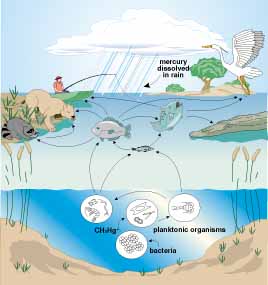Mercury
in Their Midst
When released into
the environment in substantial amounts over a period of time, mercury is a
well-documented killer, not only of wildlife but of people as well.
The raw element
itself, still called quicksilver by some, is the only common metal found
in nature that’s liquid at ordinary temperatures. Humans have found
hundreds of uses for it, from making medicines to the manufacture of other
products ranging from pesticides to paints, thermometers to hats. The
phrase “mad as a hatter” comes from centuries past, when mercury
was used in the manufacture of felt hats. A common byproduct was mentally
and physically impaired workers, hapless victims of acute mercury
poisoning.

Mercury’s
pathway into Everglades wildlife primarily begins in the
skies, with mercury-loaded rainfall. Sulfate-reducing bacteria,
mainly living in sediments and in mats of floating algae, absorb
rainwater mercury and turn it into its organic form, methylmercury
(CH3Hg+). Microorganisms which eat such
bacteria feed successive populations of larger organisms in the food
web. At each step, methylmercury levels get concentrated. For
wetland-dependent animals such as wading birds, raccoons and some
panthers, concentrations can reach dangerously high levels. (BRUCE
HALL ILLUSTRATION) |
Like most elements,
mercury is something of a chameleon, able to assume many forms. In the
environment, the most toxic form is methylmercury, a tasteless, colorless
and odorless compound that readily enters the food chain. Once in the
tissues of organisms, methylmercury has a strong tendency to stay put.
Over time, the compound can build up to dangerous levels in fish,
shellfish and other aquatic life. People and wildlife with heavy diets of
such tainted foods can accumulate the poison as well and suffer crippling,
even lethal consequences.
In the digestive
tract, methylmercury gets rapidly absorbed and can invade all tissues,
including the brain and the wombs of pregnant women. In high enough
concentrations, the neurotoxin can cause irreversable brain and nerve
damage, seizures, kidney failure, even blindness.
Of all the abuses
of mercury by manufacturers this century, by far the worst occurred in
Japan, in the vicinity of a small fishing village on the island of Kyushu.
Between 1953 and 1960, the Chisso Chemical Company dumped mercury-loaded
sludge into Minimata Bay, where it accumulated in fish and shellfish. The
pollution killed fish, seabirds, housecats--and reportedly as many as 700
inhabitants of the bayshore village. Hundreds more were crippled,
including scores of babies born with horrific birth defects.
Nothing so terrible
has happened in the U.S., although there have been numerous instances of
methylmercury poisoning. The first example to draw significant public
attention was in 1969, when some children in New Mexico got sick from
eating hog meat from animals fed mercury-treated feed grain.
As it happens,
indigenous peoples tend to eat lots of fish, which too often puts them at
risk for mercury poisoning. Miners in Brazil use tons of mercury each year
in a process for gleaning gold dust from rivers near Manaus. In the early
1990s, health officials found downstream forest peoples with methylmercury
in their systems at levels up to four times a World Health Organization
safety standard.
In 1983, Pomo
Indians in California had to stop eating so many local fish because of
high mercury in the fillets. Two bands of Indians in Ontario, Canada were
awarded an $18.6 million settlement in a 1986 lawsuit against a paper mill
that had poisoned a river that gave the Indians their livelihood.
Mercury-loaded fish from the river sickened dozens of tribe members, and
resulted in the birth of several infants with severe mental and physical
defects.
Chippewa Indians in
Wisconsin in 1990 were found to have blood levels of mercury high enough
to cause developmental problems in fetuses. The Chippewas had a fondness
for the walleye that swam in local lakes.
In Florida,
Miccosukees and Seminoles are obliged to deal with a mercury contamination
problem that defies belief. Their tribal lands are virtually synonymous
with much of the Everglades, one of the largest tracts of unsullied
wilderness left in the world--with one exception. Although statistics aren’t
clear on the point, the Everglades may have the highest levels of mercury
contamination ever seen in a freshwater ecosystem, period.
Most Everglades
fish, turtles, alligators, wading birds, raccoons and even some insects
carry mercury burdens way above normal. The average concentration of
methylmercury in a fillet of an Everglades largemouth bass is 1.5 parts
per million (ppm), three times what the state’s Department of Health
calls safe.
To many Everglades
Indians, the mercury problem is just one more insult to their environment
they must deal with, says Joe Quetone, director of the Gov. Lawton Chiles’
Council on Indian Affairs. The tribes already are battling exotic species
of fish and other wildlife, saltwater intrusion and pollution from
agribusiness. “They’ve just added mercury to the list,”
Quetone said.
Still, some tribal
leaders are fully resentful of how the ‘Glades mercury issue has been
handled by state authorities and have balked at what they call being “singled
out” by health officials for mercury testing. So far, no evidence has
surfaced that indicates a health problem tied to mercury among any of the
Everglades’ human inhabitants.
But that may be
because many Indians don’t eat fish anymore, said one Miccosukee
woman living in Big Cypress. “Nobody eats these fish around here,”
she said. “When we want fish, we do like everybody else--we go to
Publix.” --F.S.
Reposted with permission of Frank Stephenson, editor of FSU
Research in Review.
6/8/98
